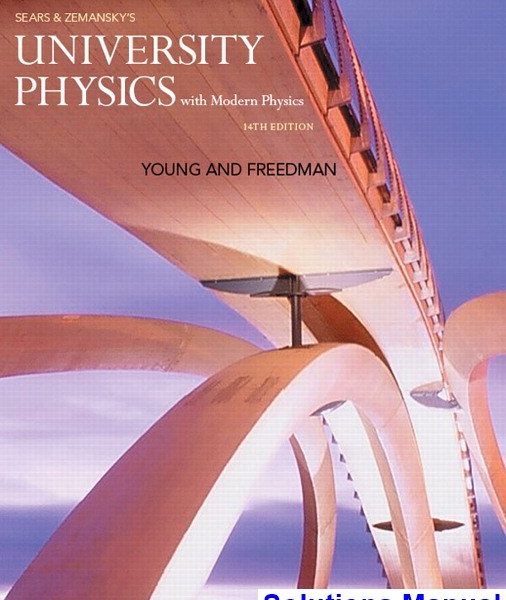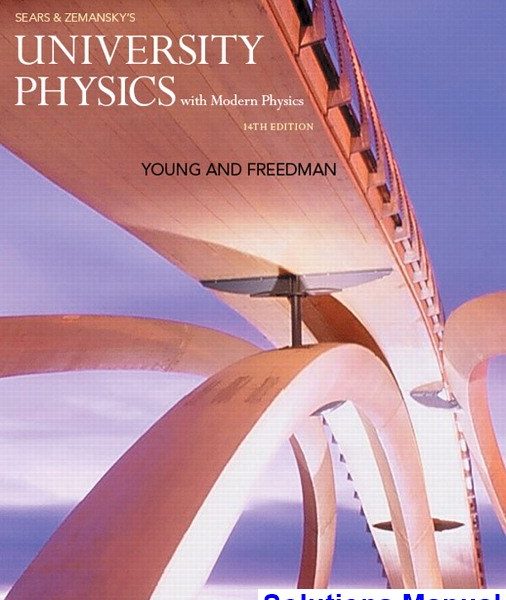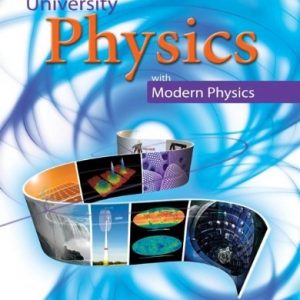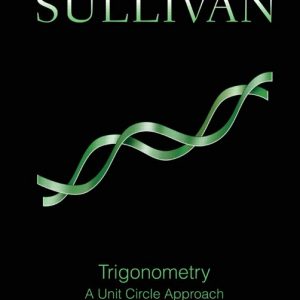This is completed downloadable of University Physics with Modern Physics 14th Edition Young Solutions Manual

Product Details:
- ISBN-10 : 9780133981711
- ISBN-13 : 978-0133981711
- Author:
The Student’s Solutions Manual provides detailed, step-by-step solutions to more than half of the odd-numbered end-of-chapter problems from the text. All solutions follow the same four-step problem-solving framework used in the textbook.
Table of Content:
- 1. Units, Physical Quantities,and Vectors
- 1.1. The Nature of Physics
- 1.2. Solving Physics Problems
- 1.3. Standards and Units
- 1.4. Using and Converting Units
- 1.5. Uncertainty and Significant Figures
- 1.6. Estimates and Orders of Magnitude
- 1.7. Vectors and Vector Addition
- 1.8. Components of Vectors
- 1.9. Unit Vectors
- 1.10. Products of Vectors
- Chapter 1 Summary
- Problems
- 2. Motion Along a Straight Line
- 2.1. Displacement, Time, and Average Velocity
- 2.2. Instantaneous Velocity
- 2.3. Average and Instantaneous Acceleration
- 2.4. Motion with Constant Acceleration
- 2.5. Freely Falling Bodies
- 2.6. Velocity and Position by Integration
- Chapter 2 Summary
- Problems
- 3. Motion in Two or Three Dimensions
- 3.1. Position and Velocity Vectors
- 3.2. The Acceleration Vector
- 3.3. Projectile Motion
- 3.4. Motion in a Circle
- 3.5. Relative Velocity
- Chapter 3 Summary
- Problems
- 4. Newton’s Laws of Motion
- 4.1. Force and Interactions
- 4.2. Newton’s First Law
- 4.3. Newton’s Second Law
- 4.4. Mass and Weight
- 4.5. Newton’s Third Law
- 4.6. Free-Body Diagrams
- Chapter 4 Summary
- Problems
- 5. Applying Newton’s Laws
- 5.1. Using Newton’s First Law: Particles in Equilibrium
- 5.2. Using Newton’s Second Law: Dynamics of Particles
- 5.3. Friction Forces
- 5.4. Dynamics of Circular Motion
- 5.5. The Fundamental Forces of Nature
- Chapter 5 Summary
- Problems
- 6. Work and Kinetic Energy
- 6.1. Work
- 6.2. Kinetic Energy and the Work–Energy Theorem
- 6.3. Work and Energy with Varying Forces
- 6.4. Power
- Chapter 6 Summary
- Problems
- 7. Potential Energy and Energy Conservation
- 7.1. Gravitational Potential Energy
- 7.2. Elastic Potential Energy
- 7.3. Conservative and Nonconservative Forces
- 7.4. Force and Potential Energy
- 7.5. Energy Diagrams
- Chapter 7 Summary
- Problems
- 8. Momentum, Impulse, and Collisions
- 8.1. Momentum and Impulse
- 8.2. Conservation of Momentum
- 8.3. Momentum Conservation and Collisions
- 8.4. Elastic Collisions
- 8.5. Center of Mass
- 8.6. Rocket Propulsion
- Chapter 8 Summary
- Problems
- 9. Rotation of Rigid Bodies
- 9.1. Angular Velocity and Acceleration
- 9.2. Rotation with Constant Angular Acceleration
- 9.3. Relating Linear and Angular Kinematics
- 9.4. Energy in Rotational Motion
- 9.5. Parallel-Axis Theorem
- 9.6. Moment-of-Inertia Calculations
- Chapter 9 Summary
- Problems
- 10. Dynamics of Rotational Motion
- 10.1. Torque
- 10.2. Torque and Angular Acceleration for a Rigid Body
- 10.3. Rigid-Body Rotation About a Moving Axis
- 10.4. Work and Power in Rotational Motion
- 10.5. Angular Momentum
- 10.6. Conservation of Angular Momentum
- 10.7. Gyroscopes and Precession
- Chapter 10 Summary
- Problems
- 11. Equilibrium and Elasticity
- 11.1. Conditions for Equilibrium
- 11.2. Center of Gravity
- 11.3. Solving Rigid-Body Equilibrium Problems
- 11.4. Stress, Strain, and Elastic Moduli
- 11.5. Elasticity and Plasticity
- Chapter 11 Summary
- Problems
- 12. Fluid Mechanics
- 12.1. Gases, Liquids, and Density
- 12.2. Pressure in a Fluid
- 12.3. Buoyancy
- 12.4. Fluid Flow
- 12.5. Bernoulli’s Equation
- 12.6. Viscosity and Turbulence
- Chapter 12 Summary
- Problems
- 13. Gravitation
- 13.1. Newton’s Law of Gravitation
- 13.2. Weight
- 13.3. Gravitational Potential Energy
- 13.4. The Motion of Satellites
- 13.5. Kepler’s Laws and the Motion of Planets
- 13.6. Spherical Mass Distributions
- 13.7. Apparent Weight and the Earth’s Rotation
- 13.8. Black Holes
- Chapter 13 Summary
- Problems
- 14. Periodic Motion
- 14.1. Describing Oscillation
- 14.2. Simple Harmonic Motion
- 14.3. Energy in Simple Harmonic Motion
- 14.4. Applications of Simple Harmonic Motion
- 14.5. The Simple Pendulum
- 14.6. The Physical Pendulum
- 14.7. Damped Oscillations
- 14.8. Forced Oscillations and Resonance
- Chapter 14 Summary
- Problems
- 15. Mechanical Waves
- 15.1. Types of Mechanical Waves
- 15.2. Periodic Waves
- 15.3. Mathematical Description of a Wave
- 15.4. Speed of a Transverse Wave
- 15.5. Energy in Wave Motion
- 15.6. Wave Interference, Boundary Conditions, and Superposition
- 15.7. Standing Waves on a String
- 15.8. Normal Modes of a String
- Chapter 15 Summary
- Problems
- 16. Sound and Hearing
- 16.1. Sound Waves
- 16.2. Speed of Sound Waves
- 16.3. Sound Intensity
- 16.4. Standing Sound Waves and Normal Modes
- 16.5. Resonance and Sound
- 16.6. Interference of Waves
- 16.7. Beats
- 16.8. The Doppler Effect
- 16.9. Shock Waves
- Chapter 16 Summary
- Problems
- 17. Temperature and Heat
- 17.1. Temperature and Thermal Equilibrium
- 17.2. Thermometers and Temperature Scales
- 17.3. Gas Thermometers and the Kelvin Scale
- 17.4. Thermal Expansion
- 17.5. Quantity of Heat
- 17.6. Calorimetry and Phase Changes
- 17.7. Mechanisms of Heat Transfer
- Chapter 17 Summary
- Problems
- 18. Thermal Properties of Matter
- 18.1. Equations of State
- 18.2. Molecular Properties of Matter
- 18.3. Kinetic-Molecular Model of an Ideal Gas
- 18.4. Heat Capacities
- 18.5. Molecular Speeds
- 18.6. Phases of Matter
- Chapter 18 Summary
- Problems
- 19. The First Law of Thermodynamics
- 19.1. Thermodynamic Systems
- 19.2. Work Done During Volume Changes
- 19.3. Paths between Thermodynamic States
- 19.4. Internal Energy and the First Law of Thermodynamics
- 19.5. Kinds of Thermodynamic Processes
- 19.6. Internal Energy of an Ideal Gas
- 19.7. Heat Capacities of an Ideal Gas
- 19.8. Adiabatic Processes for an Ideal Gas
- Chapter 19 Summary
- Problems
- 20. The Second Law of Thermodynamics
- 20.1. Directions of Thermodynamic Processes
- 20.2. Heat Engines
- 20.3. Internal-Combustion Engines
- 20.4. Refrigerators
- 20.5. The Second Law of Thermodynamics
- 20.6. The Carnot Cycle
- 20.7. Entropy
- 20.8. Microscopic Interpretation of Entropy
- Chapter 20 Summary
- Problems
- 21. Electric Charge and Electric Field
- 21.1. Electric Charge
- 21.2. Conductors, Insulators, and Induced Charges
- 21.3. Coulomb’s Law
- 21.4. Electric Field and Electric Forces
- 21.5. Electric-Field Calculations
- 21.6. Electric Field Lines
- 21.7. Electric Dipoles
- Chapter 21 Summary
- Problems
- 22. Gauss’s Law
- 22.1. Charge and Electric Flux
- 22.2. Calculating Electric Flux
- 22.3. Gauss’s Law
- 22.4. Applications of Gauss’s Law
- 22.5. Charges on Conductors
- Chapter 22 Summary
- Problems
- 23. Electric Potential
- 23.1. Electric Potential Energy
- 23.2. Electric Potential
- 23.3. Calculating Electric Potential
- 23.4. Equipotential Surfaces
- 23.5. Potential Gradient
- Chapter 23 Summary
- Problems
- 24. Capacitance and Dielectrics
- 24.1. Capacitors and Capacitance
- 24.2. Capacitors in Series and Parallel
- 24.3. Energy Storage in Capacitors and Electric-Field Energy
- 24.4. Dielectrics
- 24.5. Molecular Model of Induced Charge
- 24.6. Gauss’s Law in Dielectrics
- Chapter 24 Summary
- Problems
- 25. Current, Resistance, and Electromotive Force
- 25.1. Current
- 25.2. Resistivity
- 25.3. Resistance
- 25.4. Electromotive Force and Circuits
- 25.5. Energy and Power in Electric Circuits
- 25.6. Theory of Metallic Conduction
- Chapter 25 Summary
- Problems
- 26. Direct-Current Circuits
- 26.1. Resistors in Series and Parallel
- 26.2. Kirchhoff’s Rules
- 26.3. Electrical Measuring Instruments
- 26.4. R-C Circuits
- 26.5. Power Distribution Systems
- Chapter 26 Summary
- Problems
- 27. Magnetic Field and Magnetic Forces
- 27.1. Magnetism
- 27.2. Magnetic Field
- 27.3. Magnetic Field Lines and Magnetic Flux
- 27.4. Motion of Charged Particles in a Magnetic Field
- 27.5. Applications of Motion of Charged Particles
- 27.6. Magnetic Force on a Current-Carrying Conductor
- 27.7. Force and Torque on a Current Loop
- 27.8. The Direct-Current Motor
- 27.9. The Hall Effect
- Chapter 27 Summary
- Problems
- 28. Sources of Magnetic Field
- 28.1. Magnetic Field of a Moving Charge
- 28.2. Magnetic Field of a Current Element
- 28.3. Magnetic Field of a Straight Current-Carrying Conductor
- 28.4. Force Between Parallel Conductors
- 28.5. Magnetic Field of a Circular Current Loop
- 28.6. Ampere’s Law
- 28.7. Applications of Ampere’s Law
- 28.8. Magnetic Materials
- Chapter 28 Summary
- Problems
- 29. Electromagnetic Induction
- 29.1. Induction Experiments
- 29.2. Faraday’s Law
- 29.3. Lenz’s Law
- 29.4. Motional Electromotive Force
- 29.5. Induced Electric Fields
- 29.6. Eddy Currents
- 29.7. Displacement Current and Maxwell ’s Equations
- 29.8. Superconductivity
- Chapter 29 Summary
- Problems
- 30. Inductance
- 30.1. Mutual Inductance
- 30.2. Self-Inductance and Inductors
- 30.3. Magnetic-Field Energy
- 30.4. The R-L Circuit
- 30.5 The L-C Circuit
- 30.6. The L-R-C Series Circuit
- Chapter 30 Summary
- Problems
- 31. Alternating Current
- 31.1. Phasors and Alternating Currents
- 31.2. Resistance and Reactance
- 31.3. The L-R-C Series Circuit
- 31.4. Power in Alternating-Current Circuits
- 31.5. Resonance in Alternating-Current Circuits
- 31.6. Transformers
- Chapter 31 Summary
- Problems
- 32. Electromagnetic Waves
- 32.1. Maxwell ’s Equations and Electromagnetic Waves
- 32.2. Plane Electromagnetic Waves and the Speed of Light
- 32.3. Sinusoidal Electromagnetic Waves
- 32.4. Energy and Momentum in Electromagnetic Waves
- 32.5. Standing Electromagnetic Waves
- Chapter 32 Summary
- Problems
- 33. The Nature and Propagation of Light
- 33.1. The Nature of Light
- 33.2. Reflection and Refraction
- 33.3. Total Internal Reflection
- 33.4. Dispersion
- 33.5. Polarization
- 33.6. Scattering of Light
- 33.7. Huygens’s Principle
- Chapter 33 Summary
- Problems
- 34. Geometric Optics
- 34.1. Reflection and Refraction at a Plane Surface
- 34.2. Reflection at a Spherical Surface
- 34.3. Refraction at a Spherical Surface
- 34.4. Thin Lenses
- 34.5. Cameras
- 34.6. The Eye
- 34.7. The Magnifier
- 34.8. Microscopes and Telescopes
- Chapter 34 Summary
- Problems
- 35. Interference
- 35.1. Interference and Coherent Sources
- 35.2. Two-Source Interference of Light
- 35.3. Intensity in Interference Patterns
- 35.4. Interference in Thin Films
- 35.5. The Michels on Interferometer
- Chapter 35 Summary
- Problems
- 36. Diffraction
- 36.1. Fresnel and Fraunhofer Diffraction
- 36.2. Diffraction from a Single Slit
- 36.3. Intensity in the Single-Slit Pattern
- 36.4. Multiple Slits
- 36.5. The Diffraction Grating
- 36.6. X-Ray Diffraction
- 36.7. Circular Apertures and Resolving Power
- 36.8. Holography
- Chapter 36 Summary
- Problems
- 37. Relativity
- 37.1. Invariance of Physical Laws
- 37.2. Relativity of Simultaneity
- 37.3. Relativity of Time Intervals
- 37.4. Relativity of Length
- 37.5. The Lorentz Transformations
- 37.6. The Doppler Effect for Electromagnetic Waves
- 37.7. Relativistic Momentum
- 37.8. Relativistic Work and Energy
- 37.9. Newtonian Mechanics and Relativity
- Chapter 37 Summary
- Problems
- 38. Photons: Light Waves Behaving as Particles
- 38.1. Light Absorbed as Photons: The Photoelectric Effect
- 38.2. Light Emitted as Photons: X-Ray Production
- 38.3. Light Scattered as Photons: Compton Scattering and Pair Production
- 38.4. Wave–Particle Duality, Probability, and Uncertainty
- Chapter 38 Summary
- Problems
- 39. Particles Behaving as Waves
- 39.1. Electron Waves
- 39.2. The Nuclear Atom and Atomic Spectra
- 39.3. Energy Levels and the Bohr Model of the Atom
- 39.4. The Laser
- 39.5. Continuous Spectra
- 39.6. The Uncertainty Principle Revisited
- Chapter 39 Summary
- Problems
- 40. Quantum Mechanics I: Wave Functions
- 40.1. Wave Functions and the One-Dimensional Schrödinger Equation
- 40.2. Particle in a Box
- 40.3. Potential Wells
- 40.4. Potential Barriers and Tunneling
- 40.5. The Harmonic Oscillator
- 40.6. Measurement in Quantum Mechanics
- Chapter 40 Summary
- Problems
- 41. Quantum Mechanics II : Atomic Structure
- 41.1. The Schrödinger Equationin Three Dimensions
- 41.2. Particle in a Three-Dimensional Box
- 41.3. The Hydrogen Atom
- 41.4. The Zeeman Effect
- 41.5. Electron Spin
- 41.6. Many-Electron Atoms and the Exclusion Principle
- 41.7. X-Ray Spectra
- 41.8. Quantum Entanglement
- Chapter 41 Summary
- Problems
- 42. Molecules and Condensed Matter
- 42.1. Types of Molecular Bonds
- 42.2. Molecular Spectra
- 42.3. Structure of Solids
- 42.4. Energy Bands
- 42.5. Free-Electron Model of Metals
- 42.6. Semiconductors
- 42.7. Semiconductor Devices
- 42.8. Superconductivity
- Chapter 42 Summary
- Problems
- 43. Nuclear Physics
- 43.1. Properties of Nuclei
- 43.2. Nuclear Binding and Nuclear Structure
- 43.3. Nuclear Stability and Radioactivity
- 43.4. Activities and Half-Lives
- 43.5. Biological Effects of Radiation
- 43.6. Nuclear Reactions
- 43.7. Nuclear Fission
- 43.8. Nuclear Fusion
- Chapter 43 Summary
- Problems
- 44. Particle Physics and Cosmology
- 44.1. Fundamental Particles—A History
- 44.2. Particle Accelerators and Detectors
- 44.3. Particles and Interactions
- 44.4. Quarks and Gluons
- 44.5. The Standard Model and Beyond
- 44.6. The Expanding Universe
- 44.7. The Beginning of Time
- Chapter 44 Summary
- Problems
- Appendix A: The International System of Units
- Appendix B: Useful Mathematical Relations
- Appendix C: The Greek Alphabet
- Appendix D: Periodic Table of the Elements
- Appendix E: Unit Conversion Factors
- Appendix F: Numerical Constants
- Answers to Odd-Numbered Problems
- Credits
- Index
- Back Cover





